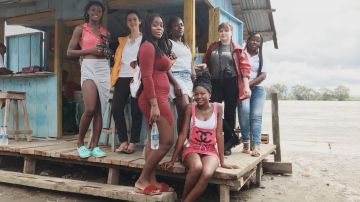Youtube #CreatorsForChange Bring Awareness to the Refugee Crisis in Colombia
The national conversation about refugees tends to leave Central and South America out of the equation

Photo: Courtesy of Rosianna Rojas
The national conversation about refugees tends to leave Central and South America out of the equation. It’s just a fact. There are millions of people moving within and between countries escaping, poverty, civil wars, narcos, femicide, domestic abuse, ecological abuse, guerrilla warfare, and widespread violence. For the millions of Latinos living in the United States, these events carry a different weight because it’s happening in familiar countries, countries where we have roots and blood. One of the most affected South American countries is also the most notorious for its violence. Shows like Narcos and countless telenovelas have immortalized the legacy of Pablo Escobar’s exploits and transgressions against the US and the Colombian Government– not that anyone who lived through that time period can forget the sensational grip the “Colombian Drug War” had on American news. Since then, little has been reported about the internal displacement and human rights abuses still occurring in Colombia. There have been a lot of false assumptions about it, the most prevalent being that the country was “fixed” after the Colombian government reached a truce with the Fuerzas Armadas Revolucionarias de Colombia or FARC, the militia group they’ve been fighting for more than 50 years.
Internal displacement is defined as: persons who have been forced from or had to flee their homes but within their country’s borders. They are often referred to as refugees although they do not fall within the legal definitions of the term. Unlike the international fixation on Colombia’s narcos, the internal displacement caused by the absence of FARC has yet to make the news. Roughly 7.6 million people — largely in Indigenous and Afro Colombian regions– have been effected by internal displacement in Colombia. And the locations are so remote that most metropolitan Colombians have no idea it’s even happening.
Last April, Youtube announced the 27 individuals from across the globe selected for the #CreatorsForChange Fellowship, which would provide mentorship, equipment, and production grants to help them further their respective missions. London native, Rosianna Rojas, was among those chosen. A Mexican Brit, Rojas wanted to further explore the Mexican refugee crisis. “I think as I’ve grown older I’ve witnessed my moms experience in the UK, she moved because she wanted to marry my Dad and for opportunities, I’ve seen more and more how hard it is and how much it hurts to be away from your family and your community and everything you know.” But she didn’t count on the extent of the very real dangers presented by the narcos.
Mexico is second only to Syria on the list of the most dangerous countries to be a journalist. In 2017 alone, twelve Mexican journalists were killed in retaliation for their work. “Unfortunately because the nature of the [Mexican] crisis there is a much higher chance of eventual attacks. It became a huge obstacle. We were talking about other options and Colombia came up because of the peace agreement between the FARC and the Colombian Government. So that was kind of a tentpole. I didn’t even think about the displacement that is ongoing because of the armed conflict in Colombia,” Rojas told HipLatina. Colombia seemed a good place to start but proved to have its own challenges, chiefly the enormous scale of those affected as well as the dense jungles that separate them from the rest of the world.
With her small crew Rojas traveled to Riosucio, Colombia a small remote town in the Country’s Chocó municipality. The region is so remote that Rojas and her crew had to take four planes, several taxis, and a four-hour boat ride to get there. Once in Riosucio, Rojas met with the UN Refugee Agency to see and hear first hand experiences of what it has been like since the peace agreement was signed between FARC-EP and the Colombian government. The videos for her project were made and edited by the students of the Interethnic School made up of Afro-Colombian and Indigenous youths who have been displaced.

“Over the course of five decades more than 250,000 people were murdered and 46,000 people disappeared,” Rosianna Rojas tells the camera. “First of all the conflict isn’t between guerilla groups, as I’d assumed, but between guerrilla groups and paramilitary groups, the latter officially known now as post demobilized groups. The groups are fighting for control over the territory.” The 2016 Colombian peace agreement between the FARC-EP and the government did not include guerrilla or paramilitary groups. “Paramilitary groups were formed in response to guerrilla groups, broadly speaking this is when business men and landowners hired their own military,” she says. Now, the fight for the land ownership has locked residents in a new cycle of horror as thousands flee landmines, forced recruitment, attacks on schools, and mass murders. Between January and November of 2017, 13,384 people were displaced by the crossfire. Rojas’ hopes to bring awareness to the detrimental effects these new conflicts are having on the lives of the most vulnerable populations.
“I want to change the perception of refugees in our culture. We have all these assumptions– but people don’t understand that you still want home, you always want to go back home you just can’t get there or put your family at risk.”
Make sure to subscribe to Rosianna’s Youtube channel. Here a few ways you can help:
- Donate to UNHCR, the UN Refugee Agency
- Sign the petition to tell the world that you stand #withRefugees
- Read up about UNHCR’s projects
This project was made possible by the YouTube Creators for Change Program. For more info go to: YouTube.com/CreatorsForChange

















